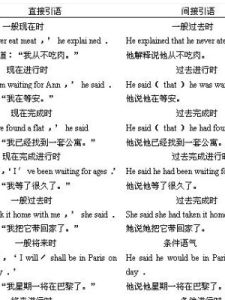正文
陳述句(DeclarativeSentence)是陳述一個事實或者說話人的看法。陳述句的句末必須使用句號(FullStop)“.”,以示句子的陳述結束。陳述句在書寫時句末有句號,而在朗讀時則用降調。
 陳述句
陳述句陳述句又分為肯定的陳述句和否定的陳述句,簡稱為肯定句(TheAffirmativeSentence)和否定句(TheNegativeSentence)。
語序
陳述句是用來描述一個事實。日常生活中使用的大部分句子都是陳述句。在陳述句中動詞在第二位。第一位可以是主語,也可以是狀語,還可以是賓語。而不管句子怎么變,動詞(或者助動詞)總是在第二位。主語的位置則總是在動詞的兩邊,要么在第一位,要么在第三位。當出現助動詞或情態動詞時,助動詞或情態動詞在第二位,行為動詞在最後一位。分類
簡單地說,表達事物的“Yes”這一面的句子就是肯定句,“No”的一面的就叫做否定句。傳統的英語入門都是先學肯定句,然後再學肯定句的反面,亦就是否定句。
一、肯定句:基本結構為主+謂
He went to London to pass his holiday.
二、否定句:
1、全否定
用not, no, never, neither, none, nothing等否定。表示“完全不是,完全不”的意思。
Nothing is wrong with me.
2、半否定句
在句子裡用否定詞hardly, scarcely, little, few, seldom, rarely等。
I hardly see anything in the room.=I can see little in the room.
“all/both/every/each/+謂語+not”表示概念為“有的是,有的不是”
All of them are not students.=Some of them are students, some are not.
3、賓語從句的否定形式
用在think, believe, suppose引導的賓語從句里則否定主句。
I don't think he'll come.=He will not come in fact, I think.
三、否定句的表達方式
(1)使用副詞否定詞“not”
(a)be,have為主要動詞
He has not many friend here. (在這裡他沒有很多朋友。)
解說:“be/have +not”常縮短成一詞,尤其是日常談話更是如此。
“am +not”不是“amn't”,而是“aren't”或“ain't[eint]”,
I am very nice to you, aren't I? (我對你很不錯,是不是?)
美國人用“ain't”很隨便,應該是“are not,is not,have not,has not”的地方,他們也會“ain't”一下就帶過去,宜注意。
(b)be,have為助動詞
He hasn't yet paid the money. (他尚未付錢。)
be+ V -ing(進行時),be +P.P.(過去分詞)(被動詞態),have(has,had)+P.P.(完成時)等的“be,have(has,had)”皆為助動詞。
“be going to …”在學校文法中也常被視為助動詞。
(c)“助動詞+V”時
動詞帶有助動詞“will,shall,can,may,must,need,dare,ought to,used to,had better”等時,將“not”置於助動詞與主要動詞之間。
You had better not tell her everything. (你最好不要樣樣事情都告訴她。)
註:“can”的否定形式是“cannot / can't”,不可寫成“can not /cann't”。
(d)使用助動詞“do”的否定句
一般動詞的否定句通常使用助動詞“do”,句式如下:do(does, did)+not + V(原形動詞)
Don't believe him. (不要相信他的話。)
註:“have”表達“有”以外的意義時,其否定句通常使用助動詞“do
We didn't have (=enjoy) a good time there yesterday. (昨天我們在那裡玩得不愉快。)
不過美式英語“have”作“有”的意義使用時也如一般動詞使用助動詞“do”
I don't have brothers. (我沒有兄弟。)
(2)使用“not”以外的否定詞:
(a)副詞:never,seldom,hardly,little,neither等
She seldom comes to see me. (她不常來看我。)
(b)形容詞:no,few,little等
He has few friends in Hong Kong. (他在香港幾乎沒有朋友。)
(c)代詞:nothing,nobody,none等
I found nobody about computer. (在那棟房子裡我沒看到任何人。)
註:
1.有些文法書認為“Not +V”為句子否定法,是否定句,而“no +n.或如nothing等”為單詞否定法,不宜稱為否定句。
He has no breakfast. (他沒有早餐可吃。——單詞否定,肯定句)
They are childless.(=The don't have children.) (他們沒有小孩。)
相關語法
一、對謂語動詞否定
否定詞除了not之外,還有never, hardly, scarcely, seldom, rarely。
She scarcely spoke to him. 她很少跟他交談。
I can do nothing about it. 對這事我無能為力。
人們在陳述事實的時候,為了禮貌或者為了在說話時留有餘地,常常在說話時採用委婉陳述方式。
1、採用插入語來軟化陳述句的口氣
That will be, I think, too much for him. 我想那會使他受不了的。
He appears to have many friends here. 看來,他在這兒有許多朋友。
四、倒裝句轉化為陳述句
倒裝句轉化為陳述句only if,only then,no sooner than,hardly when , not until是引導條件狀語從句和時間狀語從句的,倒裝句改為陳述句時,先把後面的主句提前,並改寫成正常的主謂順序,然後再接從句。陳述句改為倒裝句,把狀語從句寫在前面,然後寫主句的謂語、主語和後面的句子。
練習
Ⅰ.請把下列各句改為否定句。
1.Amy is the best student in my class.
2.Jim has a lot of stamps.
3.John studies very hard this semester.
4.Bill broke the glass yesterday.
5.Did he write you a letter last week?
6.Open the window, Peter.
7.We had a walk after dinner yesterday.
Ⅱ.請把下列各句改為肯定句。
1.She doesn't have to go to school today.
2.My father doesn't go to his office by bus.
3.I didn't see him yesterday.
4.Mr. Smith won't teach us next year.
5.You need not do it today.
6.She cannot run very last.
7.She doesn't wash her clothes herself.

